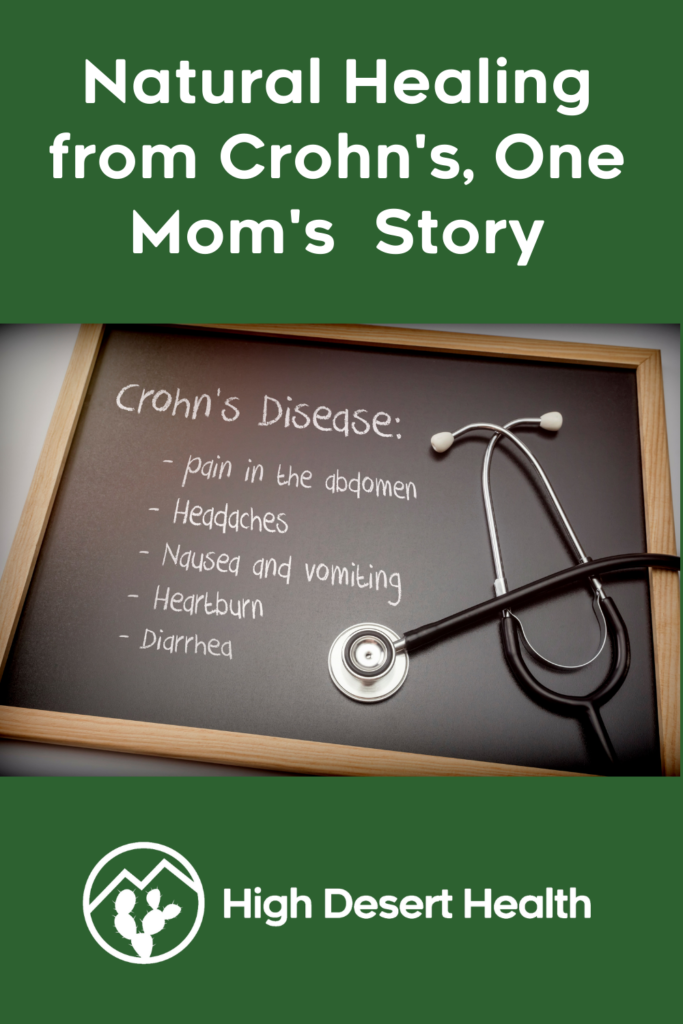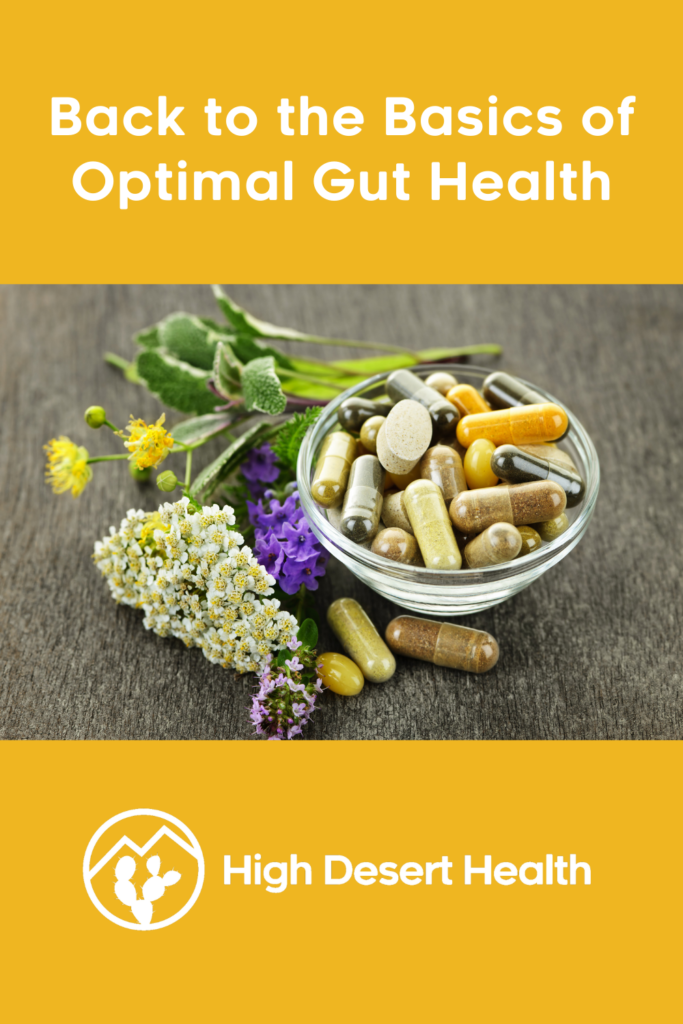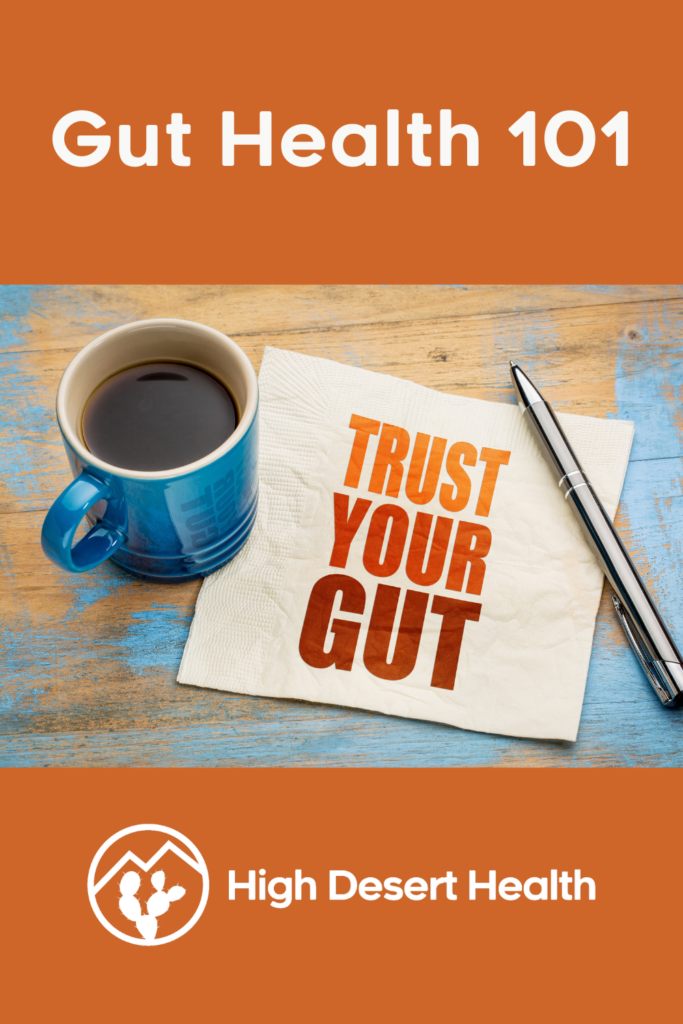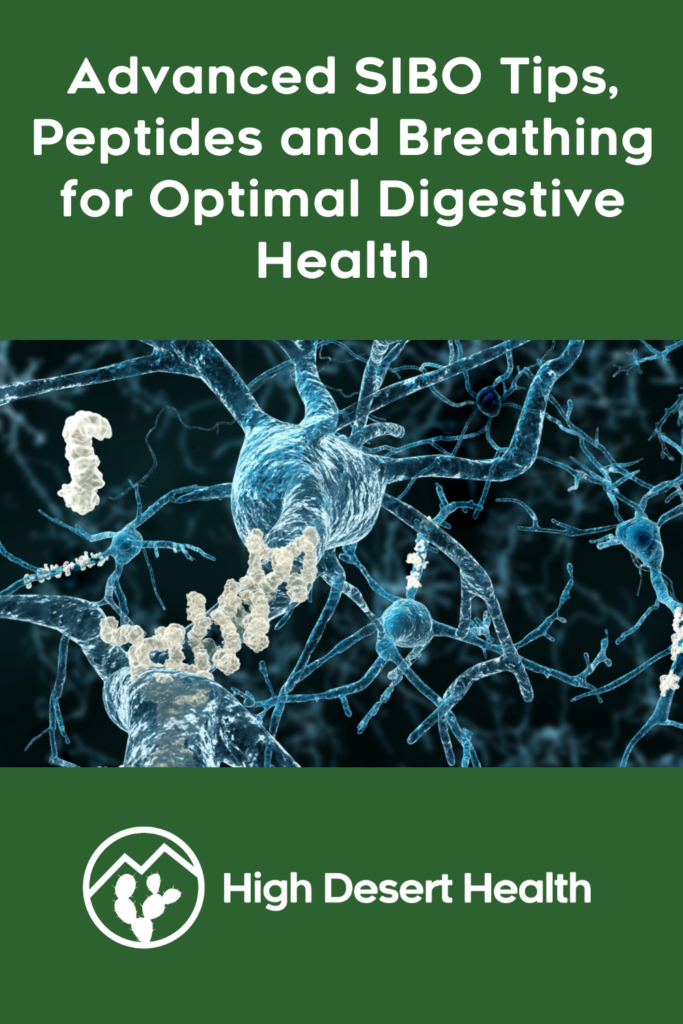
Adapted from episode 60 of The Perfect Stool podcast and edited for readability.
Lindsey:
How old your son was when he was diagnosed with Crohn’s disease and what were his symptoms that led doctors to suspect a Crohn’s diagnosis versus just calling it something that was normal for growing kids? Like with my son [when he had stomach pains] they said, “it’s just normal, rather than getting headaches, some kids get stomach aches.”
Heather Hausenblaus:
He was 16 when he was finally diagnosed, and it really was a process. Looking back, we could see it almost years in the making. But it was in the fall of his junior year that he really became quite sick. We honestly just thought it was a virus. It wasn’t until he finally said, “Mom, Dad, I have diarrhea all day.” He was really trying to hide it and live in isolation about it, because it really is something you don’t tend to talk about. We don’t tend to talk about how many times we go to the bathroom. It was my husband and I pushing and pushing and pushing through health care, when we weren’t happy with answers that we were getting. That’s really how we came to finally getting his diagnosis. We were not accepting that he’s going to be okay in a few days, he was not okay, there was something really, really wrong. It was us being an advocate for him and not giving up and having many, many doctor’s appointments until we finally got the diagnosis.
Lindsey:
Was he having pain as well? Or was it just the diarrhea?
Heather Hausenblaus:
He was having pain. It really became around the last month that he was having excruciating pain. It was really, if you can believe it, in his throat. He was saying that he had never experienced throat pain like that. We honestly thought he probably had strep or something along those lines. It wasn’t until we finally got the diagnosis we had the realization that he had ulcers because of his Crohn’s disease.
Lindsey:
Now that’s interesting, I’ve never heard of that. Were there Crohn’s ulcers all the way that high up, or was it that it was pushing up acid?
Heather Hausenblaus:
It was pushing up acid and being in the constant pain that way that was causing those ulcers literally in the back of his throat.
Lindsey:
When did it start?
Heather Hausenblaus:
The problems got really, really bad in about middle of October, and he got his official diagnosis, the beginning of December. It got to the point where we knew something’s wrong. He began to eat dinner, and then not eat anything until about lunch the next day. He would skip breakfast in hopes to get through a period or two at school. And then it became almost clockwork where I get a call from him asking me to sign him out from school, he’d come home for a couple hours, literally lie on the couch, try to eat a little bit and then get back to school for the last period. We just thought he had some weird kind of virus and we couldn’t figure it out. This went on for a few weeks. And then it was finally us going to the doctors and not leaving until we got answers. We were actually beginning to get what we felt were tests that needed to be run; not your standard tests. We said we need more. There’s something wrong. We need a stool test. We need this, we need that. And it was finally at that point where we had his pediatrician finally really listen and say, “okay, there is something wrong.”
Lindsey:
Had this been going on since he was like five or was it just a relatively new problem at 16?
Heather Hausenblaus:
Looking back, we could see signs and symptoms when he was really really young, where he would have these emergency trips to the bathroom. I have vivid memories of us leaving a restaurant, getting in the car, pulling out of the parking lot, and him speaking up in the backseat saying he had to go to the bathroom. And my husband would say, “let’s just wait till we get home.” Well, he couldn’t wait till we got home. It got to the point when he was really young, that we would always say before we leave the house, “you have to go to the bathroom.” He’d go to the bathroom, and still, almost like clockwork, we were in the car for a couple minutes and he would have to go. It usually happened after he ate. It seemed like he would go from feeling great to all of a sudden having strep or having pneumonia or having bronchitis. It was this recurring pattern with him. It seemed that stress would often trigger it. Things like the start of a school year, we could almost guarantee that he would be sick for at least a couple of days at the beginning of every school year. Looking back I can see the signs and symptoms growing over time. This didn’t happen overnight.
Lindsey:
It sounds like you started out with his pediatrician, within the traditional medical care system. Did you eventually move to seeing a naturopath or a functional medicine doctor?
Heather Hausenblaus:
We did do the traditional route with health care. He had his pediatric gastroenterologist that we felt did help with getting the diagnosis and some medical tests that he needed, but it pretty much stopped there because they really the pushed for medicine. I felt it wasn’t working. I was able to, with my background, search the drug that he was on and realize that it really was not efficacious. So, it was me using my connections within the health and wellness and functional medicine area to seek out these experts and meet with them and talk with them and realize that there’s many ways to become healthy. What we did almost instantly after he was diagnosed was dramatically change his diet. We feel that in large part was what led him on the road to recovery quickly,
Lindsey:
Had you already done your PhD? Were you already in this field?
Heather Hausenblaus:
I got my PhD about 25 years ago. So, I have been in this field of health psychology and health behaviors for a long time, doing a lot of research. My research largely focused on the psychological effects of physical activity and moving, and honestly came from the training in the background that if you exercise, you’ll be healthy. Well, it really wasn’t until he was diagnosed and we changed his diet that I realized that diet is the most important thing with this disease and with many, many diseases or conditions. If you don’t change your diet, it’s going to be very difficult to be healthy or maintain health.
Lindsey:
It’s interesting you say that, just because I do see a lot of people, my husband, for example, has a perfectly good diet for somebody who doesn’t have any health issues. But there’s this idea that if I exercise a lot, it’s okay if I eat an entire bag of potato chips (not that he does that that often). Because I’m exercising and because my weight is stable, I should be able to eat what I want to eat, no matter how junky or crappy it is.
Heather Hausenblaus:
Exactly. It’s really interesting. I fell into that category, and this is what I researched. I really felt that exercising and moving was one of the most important things we can do for our health. If you exercise, then you’re fine. My son played varsity baseball, so he was extremely active and we ate healthy. But when you do a deep dive, you realize it’s shocking, honestly, how disturbing our food actually is.
Lindsey:
Yeah, so tell me about the diet changes that he had to make and that you made as a family.
Heather Hausenblaus:
The family was a challenge, because we have three boys and Tommy’s our oldest. I’m lucky to get one meal on the table, let alone making different meals for everybody. So that became a bit of a challenge and the running joke with his younger brothers became if Tommy could eat it, then they didn’t want to eat it because they felt that it was just too healthy. We’ve come a long way. What happened when Tommy was first diagnosed, I immediately reached out to a friend whose son also had Crohn’s disease. At this point, I didn’t even know what Crohn’s disease was. She met me the following day. I talked with her and she talked about diet. She put her son on the Specific Carbohydrate Diet. I’d never heard of this diet, but I went home and began to research it. I really needed to grasp onto something and that was something that I could grasp onto. I read up on it. There was minimal science on it, but there was enough for me to say, “I need to do this,” it intuitively made sense. We went bare bones with him and followed this Specific Carbohydrate Diet for several months. Now, you fast forward two and a half years later, and he eats what I would consider a very clean diet. We’re talking about organic, lots of fruits and vegetables, grassfed meats, eliminating pretty much all sugars, anything that’s processed. Basically, if you look at an ingredient label and you can’t pronounce it, we’re not buying it. Also, he’s eating as much as possible in the house as opposed to eating out.
Lindsey:
I know that one of the things that’s particularly bad for people with Crohn’s are these gums and emulsifiers. Is that something that you had to focus on a lot with him?
Heather Hausenblaus:
I did in the sense of just going bare bones with his diet, so cutting out all sugars, all types of additives and really taking a deep dive into ingredients and honestly spending hundreds of hours trying to find products out there that we trust and didn’t have all these basic added chemicals in them. That in and of itself took so much time, and I was lucky because I was able myself to take medical leave for work because of a sick family member. I was able to take a medical leave to get my son healthy and a lot of people don’t have that opportunity. It almost became my full time job, and it’s just not right for other people not to have these opportunities to be healthy. So, my goal is to try to create awareness and make it ally’sa little bit easier for people to regain their health or the health of somebody that they love if they become sick.
Lindsey:
I may be wrong on this, but I think under the changes to the Family Leave Act that came under Clinton, we all got the ability to leave for six weeks for a family illness. Maternity leave, for example, I was able to do six weeks of that and use my sick leave time. So I think if you have a workplace of above 50 people, that applies.
Heather Hausenblaus:
I believe that is the case also.
Lindsey:
So this Specific Carbohydrate Diet, people may not be familiar with what that entails. Can you just dig a little deeper on what kinds of things are included and excluded that diet?
Heather Hausenblaus:
Yes, it’s a restrictive diet. It’s based largely on eliminating your processed foods, clearly a focus on organic, but it went much more beyond that with focusing largely on fruits and vegetables and meats. There is a list for the legal and illegal foods, and I would almost use this as a Bible and continually go back to this list to determine what are legal foods. So, foods that somebody with IBD could eat on this Specific Carbohydrate Diet. Interestingly, what continually kept coming up on this SCD or Specific Carbohydrate Diet was yogurt. Not just any type of yogurt, but a homemade fermented yogurt. I learned to make this yogurt myself, and that was something that my son was eating multiple times a day because it was almost comforting on his gut and didn’t hurt him. He ate this continually for several months. Now, you fast forward to two and a half years later, and he can’t stand the yogurt. He ate so much at the beginning. This probiotic yogurt played a really, really big role. I began to make a lot of things from scratch. For example, almond milk. I bought almond milk, because I thought it was healthy, from the grocery store but then if I looked at the label, oftentimes it was made just with almond extract, there wasn’t even almonds in it. There were all these added preservatives. So I began to make almond milk from scratch, orange juice from scratch. If I could figure out how to make it from scratch, even coming down to salad dressings, I would do that. Knowing that I had control over the ingredients, and then what he would be eating, I almost felt like I was becoming the sneaky chef and trying to sneak healthy things into the food to try to make it taste a little bit better. With this diet, you cut out all types of sugar except for natural sugar from honey, so that was a sweetener that was used in his food.
Lindsey:
When I think about the Specific Carbohydrate Diet, and I was talking on one of my previous podcasts with Dr. Steven Sandberg Lewis about this, that it’s essentially some combination of low FODMAPs and Specific Carbohydrate, right? I think it was low in a certain type of fiber, soluble or insoluble? That points to the fact that at the root of Crohn’s and Colitis may be overgrowth of bacteria. That, in essence, you’re starving out some of those bacteria by pulling out some types of fiber.
Heather Hausenblaus:
You know, it is a good question. We really don’t know enough at this point, because unfortunately, when you take a look at the research, the medical research, meaning things typically with drugs and surgery, dwarfs research within diet and nutrition, but that is changing because there have been some pretty interesting studies that are recently coming up on these different types of diets, including the Specific Carbohydrate Diet, maybe the FODMAP diet, a gluten-free diet and testing to see if this actually is an efficacious treatment for individuals with IBD. In part, they’re showing that yes, diet does play a role. Does it need to be the Specific Carbohydrate Diet? Is that the only diet to follow? No, that was the one that we grabbed onto at the beginning. It’s a difficult diet to maintain in the long term. Once he began to feel better, we loosened up a little bit and increased the number of legal foods. Now that he’s at university, and he’s on his own a lot more, he has a little bit more freedom. He’s at a point where he tells me, “Mom, I try my best to eat as healthy as possible, but sometimes it’s a little bit of a challenge.” That’s where he is right now.
Lindsey:
Was he gluten-free as part of that?
Heather Hausenblaus:
We did start off with him being gluten-free for the first couple of months. He came to me saying, “I think I can eat gluten, I don’t think that’s the problem.” So we slowly began to introduce gluten into his diet, and when I say we introduced gluten back in, we were eating really healthy to begin with. It was oftentimes sourdough bread from the local bakery that I would get that he really, really liked. So even though I say he was eating gluten, he was eating really, really high quality food. And I think oftentimes, the whole gluten thing gets couched within a lot of unhealthy foods as well.
Lindsey:
We have a local baker here and I was talking to him about the bread and he told me they use this sourdough rising process. It’s a complete process that eliminates most of the gluten from the bread by the time you’re done with it. So, right at the end, the bread that you have is a lot healthier than maybe a quick-rise bread that didn’t ferment for 24 hours or 48 hours or however long.
Heather Hausenblaus:
I even began to make my own gluten free bread for a while as well at the house. Luckily I found a bakery that was making this type of sourdough bread that you’re talking about, which was excellent for him to eat. So it’s a process. I think the take home message is that everybody is different. No one diet is necessarily going to fit everybody. So it’s trial and error, and you need to figure out what’s going to work for you. What worked for was, I don’t want to say going bare bones but, really stripping out additives and then slowly beginning to reintroduce foods to see if he could eat them. Then staying completely away from sugar and fast foods and trying to eat at the house as much as possible, because that’s where you really have control over what you’re putting in your mouth.
Lindsey:
So you said you did eventually get some more complex testing? Was there anything they found on that testing like candida overgrowth or bacteria, like SIBO or anything like that?
Heather Hausenblaus:
It was eventually treated with the testing that we did, it was a diagnosis of Crohn’s disease, and then getting the inflammation out of his body and to a level where it was normal. The cause we’ll never know 100%. Looking back, I think that it was related to early antibiotic use. I really think that’s what the cause was, because as a very young child, I remember before the age of one, he had an ear infection, and he got an antibiotic. Many times when he was young, he was getting antibiotics for different illnesses that he had. And I think that threw him off and then it was becoming worse and worse until the point where he was diagnosed.
Lindsey:
Just looking at the one pager from your book, you mentioned some simple tips that people suffering with autoimmune disease can follow to find their way back to health. What are some of those tips?
Heather Hausenblaus:
You have to listen and trust your body. Go and take a close look at your diet and what you’re eating, what you’re putting in your mouth first and foremost. If we take a look at what makes us healthy, about 50% of our health is related to our health behaviors, with the top three being our diet. Whether you smoke or don’t smoke, how much you exercise, your environment counts for about another 20%, your access to health care only accounts for about 10% and then your genetics account for about 20%. So that encompasses what makes you healthy, but the bulk is our health behaviors, making up 50% of why we’re healthy.
I want people to know that they have a lot of power over their health, because we can control our health behaviors. You have control over what you eat, you have control over how much you exercise, whether you smoke or not. Also, your sleep, which is something that we tend to forget about, but sleep is vital and it is so important to make sure that you’re getting enough sleep and keeping your stress level down.
There’s many different simple health tips. You need to take a look at your diet, how much you move or exercise during a 24-hour period, how you’re sleeping, and your stress level, as well what is causing you stress or anxiety. We saw this with our son firsthand when he was experiencing stressful periods during the school year. We saw his symptoms increase, especially when he was first diagnosed. One example was, he was supposed to take the LSAT one night. He was in pain, he wasn’t feeling good, he was running to the bathroom. It was the stress caused by having to take the LSAT, so we ended up canceling it and he took it at a later date. He finally came to us and said that he was really worried that if he had to go to the bathroom during the LSAT, what was he going to do? We never even thought about this, but then we got paperwork done so that he could get a “stop the clock.” If he did have to go to the bathroom, they would stop the clock on his LSAT, so if he was in the bathroom for 10-15 minutes, he wouldn’t lose that time on his test. These were things that we began to do for him. Getting these types of accommodations done, not only when he was taking the LSAT, but also at his high school and university as well. If he does need it, it’s in place. That actually reduces his stress, knowing that there is that opportunity for him and that if he does get stressed, or if he has to go to the bathroom during an exam, that he’s not going to lose any time on his on his test.
Lindsey:
You know, I imagine there are a lot of people who don’t think like, “oh, I’ve got this gastrointestinal thing, that’s a disability.” They could go to the Disability Services office at their school or their counselor at their high school and get those accommodations.
Heather Hausenblaus:
You’re so right. You tend not to think that this is a disability, but there are things in place to help if you’re in pain, or you’re spending that much time in the bathroom. There’s even Ally’s Law, for example, that was passed where if you’re in a store, and they have a restroom, if you have the Ally’s Law card, then you’re able to use that restroom. A lot of people don’t realize that when some people say they have to go, they have to go. There’s no waiting till later. It is an emergency.
Lindsey:
I’m totally not familiar with this Ally’s Law. Where do you get the card?
Heather Hausenblaus:
You can apply online and you’ll get it in the mail. It’s an interesting story of a girl named Ally and she had Crohn’s disease. She was shopping with her mother in a retail store, she had to go to the bathroom and she had to go right away. There were no restrooms anywhere close outside the store, so they asked to use the employees’ restroom. They were denied access and she had an embarrassing accident in the middle of the store. Her mother advocated that this would never happen to anybody else. She went through the steps to get this passed as law; it’s passed as a law in many states. You can get this card, you keep it in your wallet, and when you’re out saying, “I need to use this washroom, it’s an emergency, you can’t deny me access,” and you show the card.
Lindsey:
So, one of the topics that you seem to be passionate about is journaling for health. Can you tell me a little bit more about that?
Heather Hausenblaus:
It was a process for me when our son was first diagnosed. I was experiencing a lot of stress and anxiety and having a difficult time sleeping at night because I’d wake up in the middle of the night trying to think about what I needed to do to keep him healthy and keep some level of normalcy. This began my routine of keeping a gratitude journal or a thankful journal. It would literally only take a couple minutes, not a lot of time. It was a simple process, but it actually set my day off on a more positive note and reframed how I thought about things.
What I also immediately started to do for my son is tracking his food. I kept a food sensitivity log, basically keeping track of everything that he was eating during the day, how many times he was going to the bathroom, if he was having any symptoms and how he was feeling so that I could try to pinpoint if there were certain foods that were triggering his symptoms. I feel that was so important, to be able to track and look back at his diet and see what potential symptoms were there. That really helped him on his road to recovery. I began then, of course, as I do with most things, to dig into the science. There is a great deal of science showing that keeping a gratitude journal is extremely powerful for people’s overall health, making them more productive, putting them in a better mood and just being kinder and overall healthier, and the same thing with a food sensitivity log as well. I’m a very strong advocate for these because they are really, really simple to do. They don’t take an extreme amount of time and they’re not expensive. You can create your own journal if you want, or you can go on Amazon and buy a journal for less than $10 that will last several months. I’m a really big fan of science-based health techniques that are easy for people to do and are not overwhelming. To me, journaling and health journaling is a very simple thing to do that can create a lot of positive health effects.
Lindsey:
You know, it’s interesting, because when I began my training as a health coach and launched my business, one of the questions that they suggested we asked new potential clients is, “what are five things you love about your life?” At first, it just felt fluffy to me at the end of the questionnaire, but I left it on there because I liked hearing the answers. I’ve noticed as time has gone on, that there are people who are really suffering, and yet can still find five things that they’re very thankful for and that they love about their life. Then there’s some people who are just so down in the dumps, that they can’t find a single thing to put there. You know, I think about what the prognosis is for someone who’s got not a single bit of hope to begin with, if that it’s almost the necessary precursor to healing.
Heather Hausenblaus:
I love that you said that. You said you felt like it was almost hokey to do it, it almost seems fluffy. The simplicity of it is so brilliant, and that it does work. I know for myself, especially at the beginning, when our son was really sick, I’d have to dig deep some mornings to find even a couple things that I was thankful for. As simple as my morning cup of coffee. Over time it grows and becomes bigger, and you realize that you do have so many things to be thankful for. By keeping this gratitude journal, it really reframes how you think about things, you begin to find the silver lining in a lot of things. We do know the power of the mind, and the power of positive thinking has an incredible effect on our health.
Lindsey:
After I went through sciatica, just feeling so thankful for having my body back, and being able to walk, I’m still constantly just amazed that I’m not in excruciating pain every day, and how thankful I am for that. How thankful I am to be able bodied and, it’s one of those things that sometimes you have to have lost to understand what it is to get it back.
Heather Hausenblaus:
It’s not until we’ve lost a piece of our health that we really appreciate it. We take things for granted. A gratitude journal reframes how you think so that you’re not taking these little things for granted. You’re not taking your health, your wellness, maybe it’s your walk with your dog, your morning cup of coffee, sitting quietly or peacefully, or watching your favorite TV show, whatever it may be, that you begin not to take those things for granted.
Lindsey:
Every night before I go to bed, I just thank God for each of the things that I’m grateful for. And some of it’s just the basics, that I’m in a safe house and that I have a warm bed. I think about refugees and people who have none of that. I try and keep my perspective to be thankful for even the very basics, and we tried to do this with our kids too, we tried to have a gratefulness circle going around the dinner table. For the life of me, I couldn’t get them to look at the simple things and just be thankful. Whatever they were currently unhappy about was what they wanted to complain about rather than find something to be thankful for.
Heather Hausenblaus:
We do tend to focus more on the negative, but you bring a great point about around meals around the dinner table. When you actually do finally slow down and sit down, it’s a great opportunity just to take a couple minutes, even just a minute, to express what everyone is thankful for the day. It just kind of sets the mood and sets the tone and makes everybody sit back and say, “okay, we do actually have a lot to be thankful for.” We get just so caught up in the stress of our day-to-day, thinking we need to do more and more and more. That’s not the case, we need to really slow down and reset.
Lindsey:
And the impact on your health, I mean, what is it? What does the science say about the impact of gratefulness on your health?
Heather Hausenblaus:
It’s really quite impressive. There are hundreds of studies now showing that individuals who express gratitude, whether it’s journaling every day, being thankful, has incredible health benefits for them. It’s so simple and easy to do. It’s something that I recommend people do, whether you want to create a journal yourself or buy one that’s out there. All you literally need is a pen and some paper and you start doing your journaling.
Lindsey:
Are there any other lifestyle practices that you found were helpful for your son?
Heather Hausenblaus:
The main one was this incredible change in his diet. Trying to eat at the house as much as possible, jumping onto a diet that we felt was going to work and going bare bones and then beginning to lessen up on it over time and include more of these legal foods. I recommend people get support, you need help. I was somebody that was able to reach out to individuals within the health and wellness community and to find other parents that were going through similar things that I could meet. I actually meet for lunch or talk on the phone or go for a walking meeting. To have that type of support is extremely important not just from your health team, but also from family members or friends or people that you can relate to that are going through something that’s really, really similar. There’s so often you feel really alone, and by having or creating this community, then that will lessen. I know there’s incredible support teams now out there on the internet as well, so there is that type of support as well. My husband and I, we joined the Crohn’s and Colitis Foundation and join their walks and try to create awareness and raise money for the organization as well so that we can help other peers who are going through this.
Lindsey:
Is that foundation functional minded? It’s not just traditional medical?
Heather Hausenblaus:
There is some functional-mindedness in it, there is a large medical focus as well. You do see a focus on the diet and importance of exercise. They really do have some great outlets for family members and even for young kids who are suffering.
Lindsey:
Did you have some mentors or authors around the topic of Crohn’s disease or autoimmunity in general that you’ve followed?
Heather Hausenblaus:
At the beginning, no. When he was first diagnosed, I’d heard of Crohn’s disease, I couldn’t have even told you exactly what it was. I was really starting almost at ground zero to try to learn the disease. It was connecting with individuals, connecting with organizations. I reached out to a medical doctor, David Susskind. He actually responded to my email, and I talked with him because I was really impressed with what he was doing. He’s a medical doctor who deals with pediatric issues, in particular IBD and IBS, and he was researching SCD. I was really impressed with the fact that he listened to his patients when they came in, and as patients’ parents were saying that diet does play a role, he began to hear them talking about the Specific Carbohydrate Diet. So, he began to research it. Now he’s a very strong advocate for it, because he knows that diet does play a really big role in the help of healing from this disease. He also realizes how difficult a strict diet is to follow. He’s doing some really cutting edge research on modifying the Specific Carbohydrate Diet, meaning, what happens if you include some illegal foods? Are you going to be okay? He actually has a clinical trial going on right now that hopefully will be published sometime in the near future that will bring even more light to this. I’m a big advocate of that. I began to read, honestly, everything I possibly could on Crohn’s Disease, buying a lot of books on IBD, IBS, reading people’s stories and listening podcasts. I was just trying to soak in as much information as I possibly could to try to understand what would be the best path for us.
Lindsey:
Besides David Susskind, were there books that you found particularly useful?
Heather Hausenblaus:
I think the books that I was drawn to the most were from these health, wellness, functional medicine, more naturalistic doctors’ books that were out there. In particular, I became a very big fan of Dr. Mark Hyman, he’s a functional medicine doctor.
Lindsey:
Cleveland Clinic.
Heather Hausenblaus:
Yes, I love what he has done. The books that he has written, his podcast are phenomenal. Dr. Josh Axe was another individual. I went to his website, knowing that things were going to be science based. His books are phenomenal. An individual who’s a big leader in the health/wellness industry named Naomi Whittle, as well, who’s done a lot and written some New York Times bestsellers on specific diets and how they help with overall health.
Lindsey:
Yeah, those are great resources. I hadn’t heard of Naomi, I will have to check her out. Tell me about the research that you’re doing now.
Heather Hausenblaus:
My research most recently is focusing on sleep and how sleep affects our overall health. Focusing on whether there’s a supplement, potentially a type of music, that can help us sleep better. Most recently, I’ve actually begun to take a look at some of the health effects of journaling, and how keeping a gratitude journal or keeping, for example, a movement journal, how that will help people overall on their health path, whether it will help them move more, to sleep better, to be more thankful, to be more productive or to lower their stress.
Lindsey:
On the topic of sleep, what do you find are some of the biggest obstacles to people getting good sleep and what are some of the solutions related to these obstacles?
Heather Hausenblaus:
I would say one of the biggest obstacles right now is how much we’re plugged in during the day with our life. Sleep is a behavior that we do every single day, so you would think that we’d be experts at it. Most of us are not very good sleepers. A few simple tips to help with sleep, get your electronics out of your room and do something quiet before you go to bed, read for a couple minutes. You want to create a sleep environment where you’re sleeping in a very quiet dark room and begin to have this consistent bedtime and this consistent wake time. Try to go to bed at about the same time every night and also try to wake up at about the same time every morning because we have our circadian rhythm, a circadian clock that resets every day. We’re creatures of habit. I know myself, I used to fight this for years, because I’m really more of a morning person, I love to get up around five in the morning. On the weekends, I would feel this pressure to stay up till midnight or beyond. I just stopped doing that. It didn’t work for me and would really throw off my health. For people to say, “my sleep is important and I need to make it a priority during my day.”
Also, know that what you do during the day is going to affect your sleep at night. If you don’t move enough during the day, you’re probably not going to sleep as well at night. You should try to exercise every day. You should be getting outside every day and getting that natural light, which is so important. You do need to watch what you eat as well, because certain foods can throw off your sleep, especially eating a large meal right before bedtime. These are things that people have control over. People think about sleep as a really, really important health behavior, and if they don’t get a good quality of sleep, it’s going to affect everything that they do the next day.
Lindsey:
I’ve talked to clients who are completely exhausted and they have brain fog, and they’re only getting five hours of sleep at night. That seems like it’s probably the first thing you need to address because it may not be because of the gut issue that you’ve got brain fog. It may be that the five hours of sleep are a bigger culprit.
Heather Hausenblaus:
It’s all related, your body’s going to have a hard time healing properly if you’re not getting adequate sleep. It is really, really critical. It’s important for people to say, “I’ve got to take my sleep time and know that it is so important for my health. If I’m not going to sleep well at night, it’s going to affect everything. The next day, I’m not going to be as productive. I’m going to be grumpy, or I’m probably not going to eat as healthy.” Have you ever noticed what type of foods you begin to crave when you’re tired?
Lindsey:
Oh, yeah. An instand pick me up with the carbs.
Heather Hausenblaus:
Exactly. People need to realize that sleep is important. There’s many things that I can do to sleep better that are in my control that I do have control over.
Lindsey:
One thing that I hear a lot from clients is, “I don’t have any trouble getting to sleep, but I’m waking up at three in the morning.” Is there a solution for that one?
Heather Hausenblaus:
Oh, gosh, I wish there was a simple solution to that. It’s really common that people say, “my problem is I wake up in the middle of night, have to go to the bathroom, or I just wake up and then my mind goes into overdrive, I begin to think about everything that I have to do. And it will take me an hour or two to fall back asleep. And by the time I fall back asleep, it’s time for me to get up.” Once again, take a look at your entire sleep environment. If you do wake up and you begin to get a little bit anxious, you’re having a difficult time falling asleep, don’t just lie there for an hour or two. Get up out of your bed, go somewhere quiet, pick up a book begin to read or listen to some really relaxing music. You’ve got to do something just a little bit different until you begin to get groggy again, and then go back to bed. I find for myself, that’s what works.
Lindsey:
You need to associate your bed with sleep not with agonizing over the details of your life.
Heather Hausenblaus:
Exactly. You don’t want your bed and your bedroom to be this stressful environment that provokes you. There’s many individuals who almost dread going to sleep because they fear that they are going to wake up in the middle of the night, it’s going to be the same routine and they won’t be able to fall back asleep. You have to ask, “what can I do about it?” Maybe it’s as simple as picking up a journal and writing in it for a few minutes; that may make you tired. Again, don’t turn on the TV. You certainly don’t want to do that. Do something quiet, and what’s often recommended is reading or listening to soothing types of music. We do know that listening for example to relaxing types of music, like classical music or like something like wholetones, does actually promote sleep.
Lindsey:
I had a yoga nidra CD I scanned in ages ago and I will put that in my earphones if someone else is in the room or just out loud if not, and that will be my go back to sleep or at least if not go back to sleep do something relaxing that is supposed to be somewhat equivalent to sleep.
Heather Hausenblaus:
That’s so important to do and I know this might sound a little kooky, but I now typically sleep with a sleep mask on so that everything is dark in my room. Sometimes I’ll even put in earplugs, because I can hear the noises, my kids may still be up or whatever, because I do tend to go to bed a little bit on the earlier side.
Lindsey:
Speaking of circadian rhythm and going to bed early, I think that’s a battle that many people struggle with, which is, waking up at 5 in the morning, well, then you’re going to have to go to bed at like 8 at night, right? There’s only so many ways to add up to 8 or 9. And it’s not going to be going to bed at 11 and waking up at 5.
Heather Hausenblaus:
That’s a good point that you bring up because not everybody needs the eight hours of sleep, some people can actually operate on less sleep, some people may need a little bit more. But that’s on average, the average person needs between seven, eight hours of sleep. What I recommend people do is, if you wake up without your alarm clock, that means that you’ve had enough sleep. If your body wakes up naturally, then that’s telling you’ve had enough sleep. If you’re waking up with an alarm clock, then you didn’t have enough sleep that night. I know, we can’t do this every day, but potentially on the weekends, try to see when is that time or when is that point that you wake up naturally, and then count back and say, “this is how many hours I seem to need on a regular and consistent basis to get an adequate amount of sleep.” We’ll say it’s seven hours of sleep. Then take a look at that and say, “if I need to get up at five in the morning, then this is the time that I should be going to bed so that I get those seven hours of sleep.
Lindsey:
You have to keep in mind too, that you’re not falling asleep instantly, and that you may be lying in bed for a few minutes after you wake up. So you have to add in a little fat, you can’t just go to bed seven hours exactly before you’re going to wake up.
Heather Hausenblaus:
Factor in that buffer period. Typically, it doesn’t take us too long to fall asleep, it shouldn’t be taking more than five to 10 minutes. When your head hits the pillow you should be out and then when you wake up in the morning, you should pretty much be ready to go if you’re waking up without an alarm clock.
Lindsey:
For me, if I don’t take melatonin, then I can’t fall asleep within five or 10 minutes. It’ll take me 15 to 30 minutes.
Heather Hausenblaus:
Everybody is so individual. Maybe it’s, you know, a hot cup of chamomile tea. One of the tricks that I have that I learned from Dr. Michael Bruce, who’s a sleep expert and has written some wonderful books on the science of sleep, recommends hot water and you put a banana in in the hot water and just let it seep for a couple minutes. The banana still has its peel on, you just cut the ends off of the banana, put it in a cup of hot water and just let it seep for a couple of minutes. And then you take the banana out, you drink this hot water that has a hint of banana. It’s actually enjoyable to drink, but it’s the potassium that’s in it that actually helps with sleep. And that’s a really simple easy thing to do.
Lindsey:
Organic banana, unless you want a glass of pesticides.
Heather Hausenblaus:
Yes, exactly. Good point.
Lindsey:
I appreciate you sharing your story about your son with us. I know there’s probably a lot of parents out there struggling to help their kids get back to health. Crohn’s is a very serious diagnosis, I know someone whose child died of this, so I’m glad to hear about your story and that it turned out so much better and that you’ve written a book to help other people. Where can people find you and your book?
Heather Hausenblaus:
They can find me at https://www.heatherhausenblas.com/. That’s where the book is. For information that I have on journaling and health and blogs that I’ve written, people can go to https://www.healthymovesjournaling.com/.
Lindsey:
Any final thoughts for our readers?
Heather Hausenblaus:
If anything, I want to tell people that they have the power to be healthy and to really take control of what they’re doing and to critically take a look at their diet and how much they’re moving and sleeping at night and really take a look at journaling as a positive health thing that they can do.
Lindsey:
Great. Well, thank you so much for talking with us today.
Heather Hausenblaus:
Thank you so much for having me and thank you for everything that you do.
If you’re struggling with Crohn’s Disease or any type of gut health problem and are ready to get some professional help, you’re welcome to set up a free, 30-minute breakthrough session with me. We’ll talk about what you’ve been going through and I’ll tell you about my gut health coaching 5-appointment program in which I recommend lab tests, educate you on what the results mean and the protocols used by doctors to fix the problems revealed. Or if you’re ready to jump in right away or can just afford one appointment at a time, you can set up an 1-hour consultation with me.















